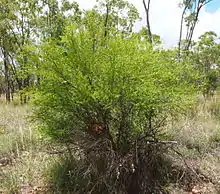| Erythroxylum australe | |
|---|---|
 | |
| Scientific classification | |
| Kingdom: | Plantae |
| Clade: | Tracheophytes |
| Clade: | Angiosperms |
| Clade: | Eudicots |
| Clade: | Rosids |
| Order: | Malpighiales |
| Family: | Erythroxylaceae |
| Genus: | Erythroxylum |
| Species: | E. australe |
| Binomial name | |
| Erythroxylum australe F.Muell. | |
Erythroxylum australe is a shrub or small tree endemic to northern Australia. The plant is known by a variety of names including Brigalow erythroxylon shrub and dogwood (unrelated to Cornus).
The plant grows in a wide variety of habitats in subcoastal and coastal regions, ranging from dry rainforest and vine thickets to open savanna woodland.
The leaves contain 0.8% meteloidine, an alkaloid similar to cocaine. All Erythroxylaceae species are banned in NSW.[1]

Erythroxylum australe foliage.
References
This article is issued from Wikipedia. The text is licensed under Creative Commons - Attribution - Sharealike. Additional terms may apply for the media files.